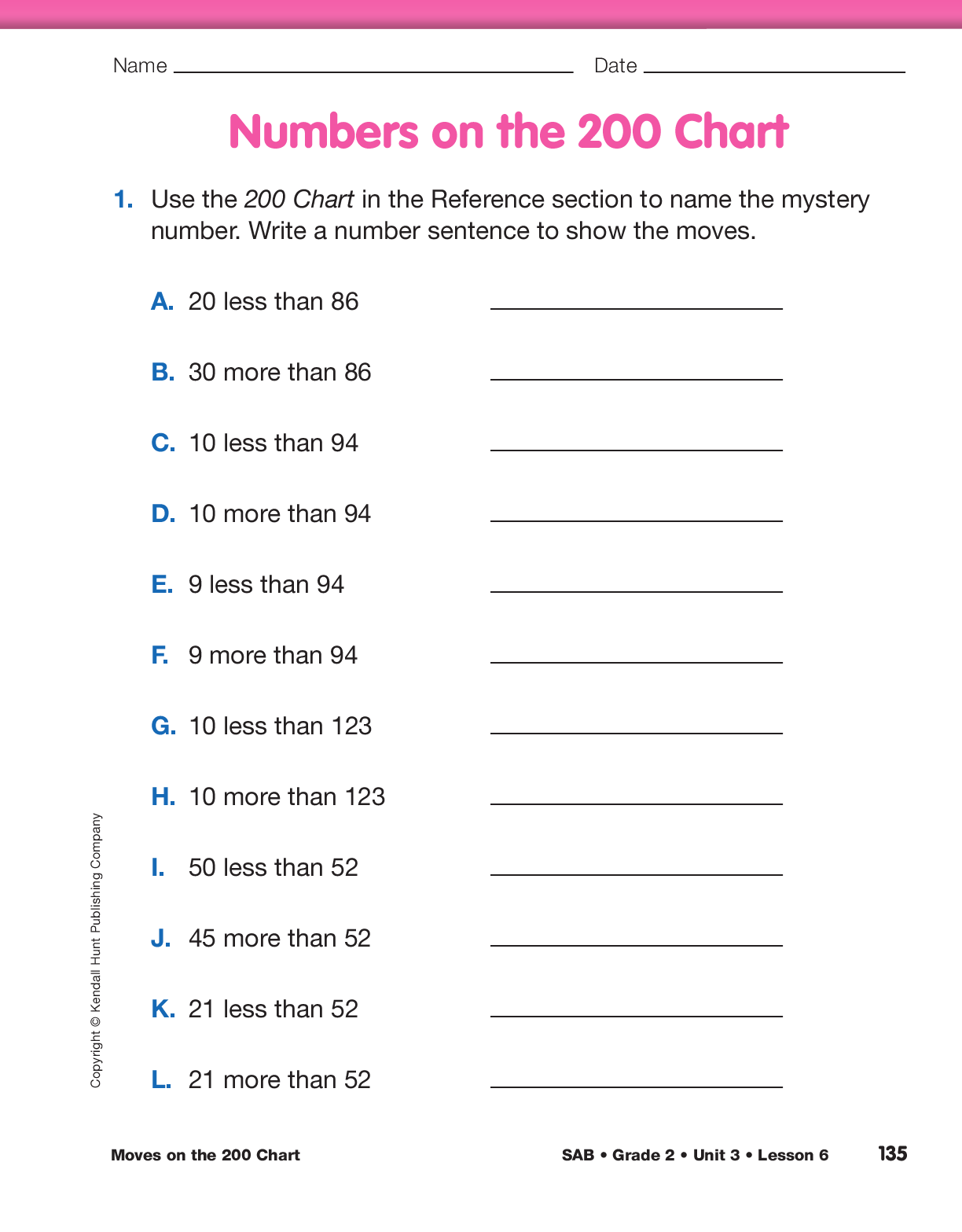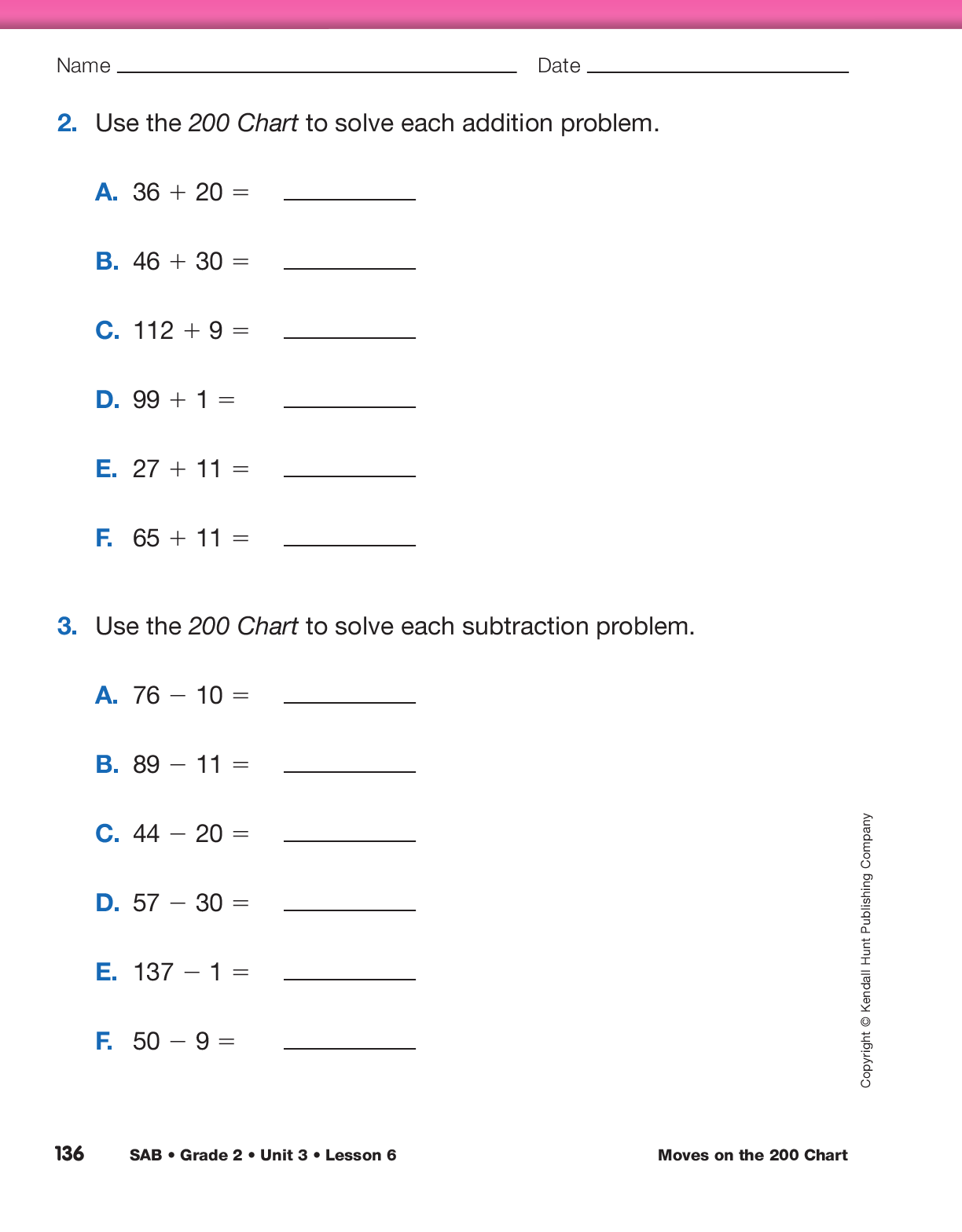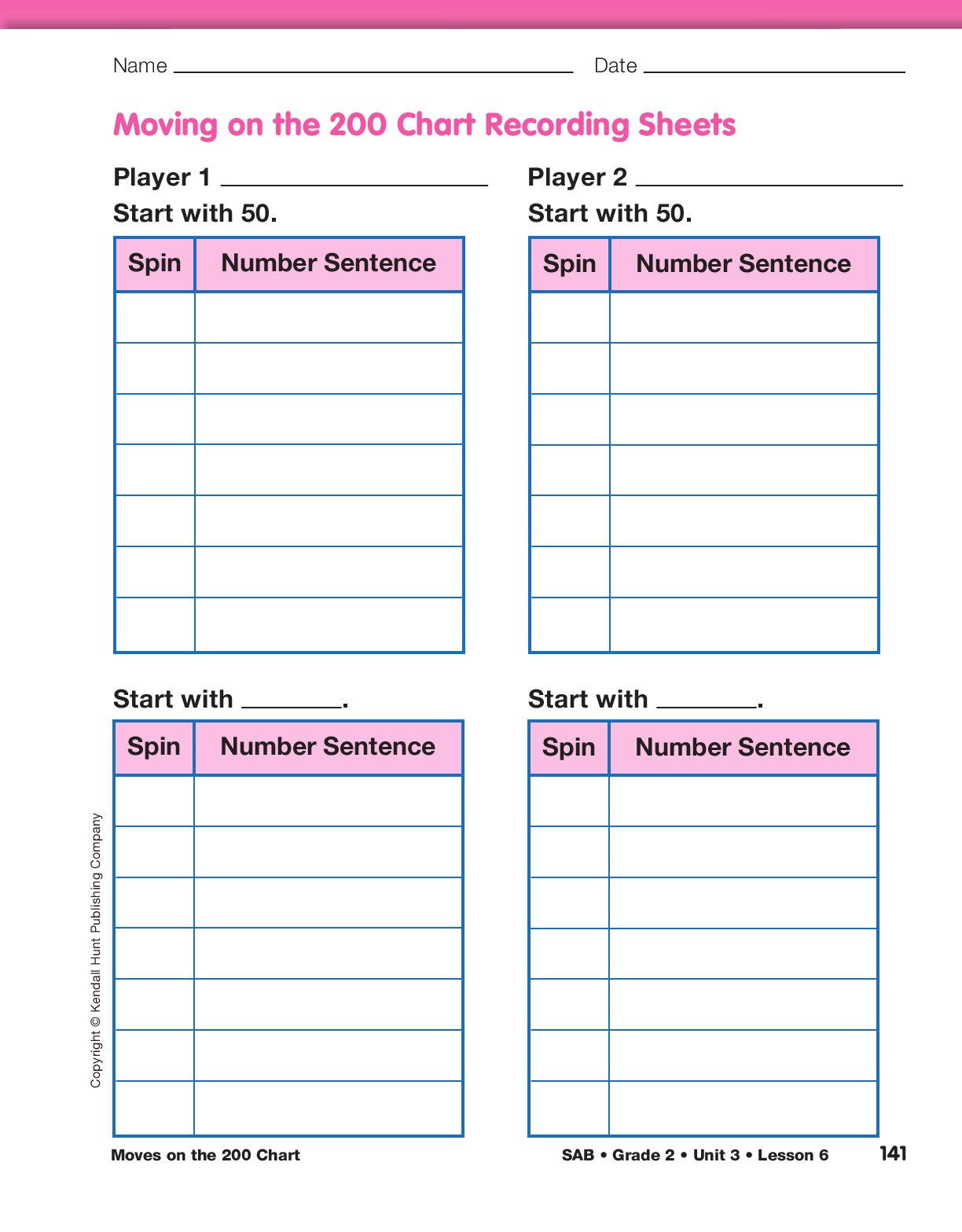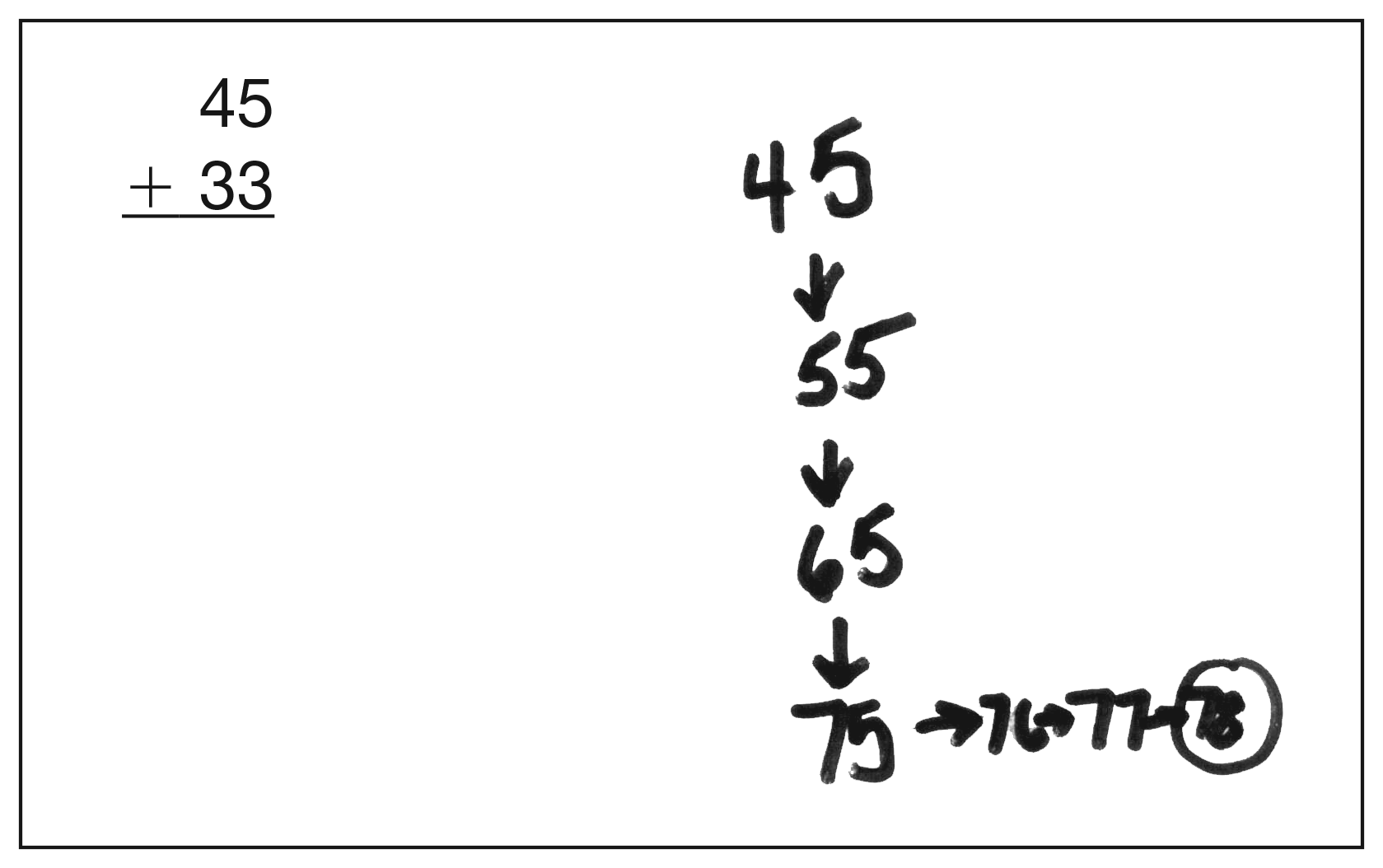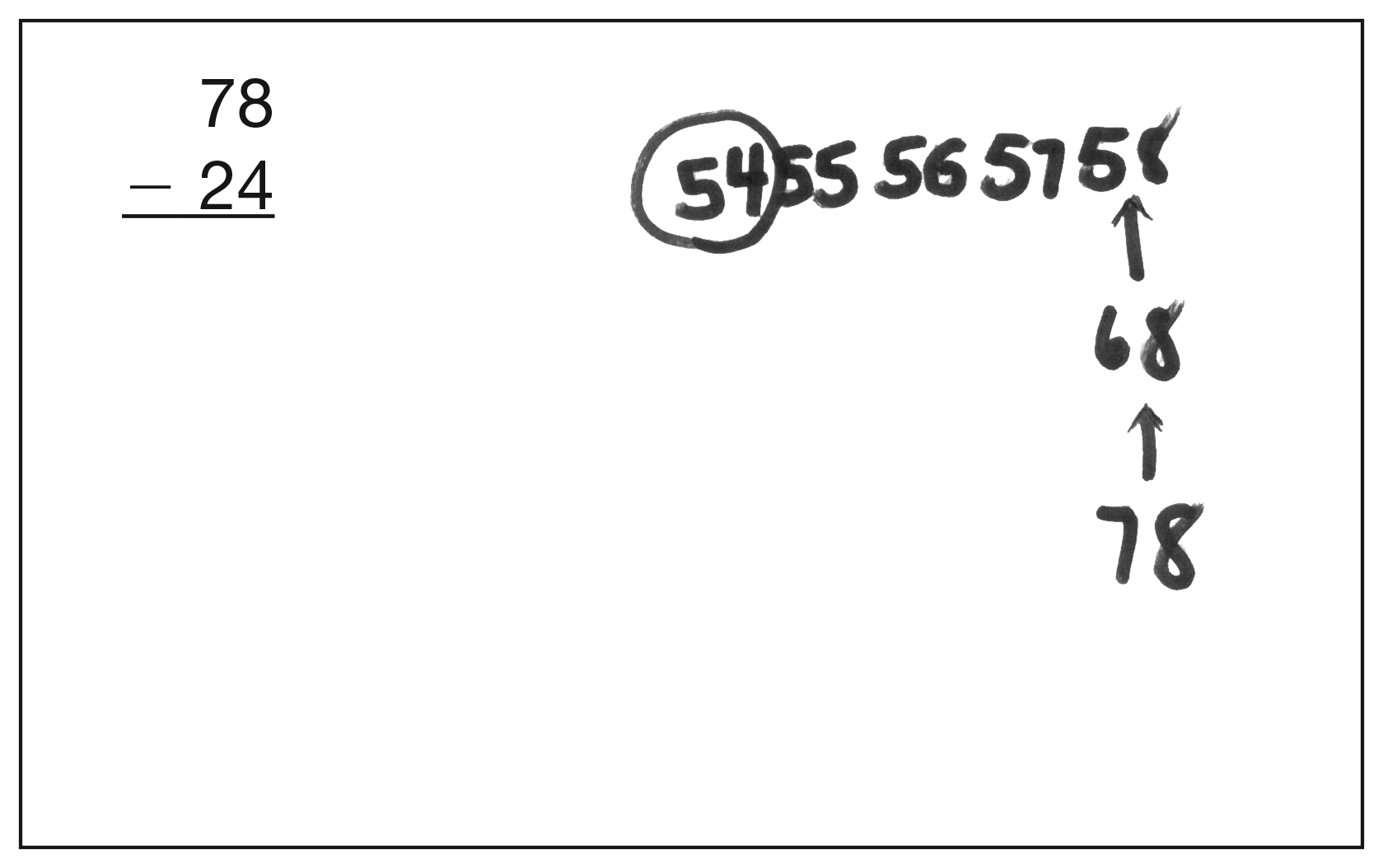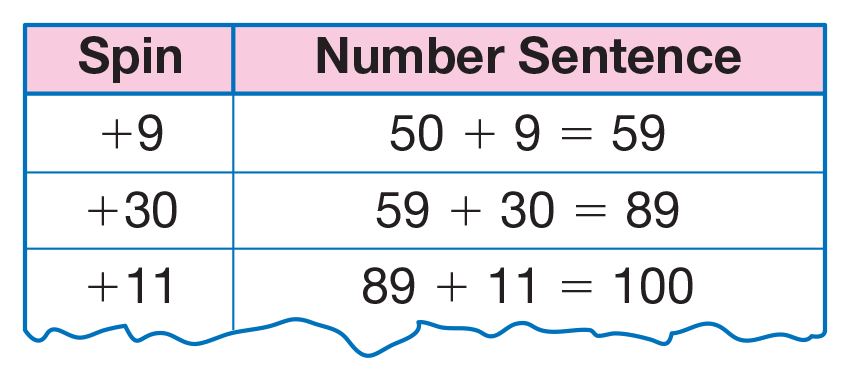Use the 200 Chart to Add.
Use the display of the
200 Chart from the Student Activity Book Reference
section to demonstrate how to add on the 200 Chart.
Begin by adding numbers such as 10, 20, 30, 9, and
11 repeatedly to different numbers.
- What happens when you add 10? How far do you move? (Possible response: I move exactly one row below.)
- How does adding 11 compare to adding 10? Describe where you land. (Possible response: I
move one row below and one space to the right. I go to the right one space because 11 is one more than 10.)
- How does adding 9 compare to adding 10? (Possible response: When I add 9 to a number I
move one row below and one space left. I go to the left one space because 9 is one less than 10.)
- What happens when you add 30 + 20? (Possible response: I go two rows below 30 to land on 50.)
- What happens when you add 36 + 20? (Possible response: I go two rows below 36 to land on 56.)
- What happens when you add 36 + 9? Describe how you move and where you land. (Possible
response: I start at 36. I move one row below 36 to 46 and to the left one space to 45.)
- What happens when you add 36 + 11? Describe how you move and where you land. (Possible
response: I start at 36. I go one row below 36 to 46 and right one space to 47.)

Point out the relationship between the terms “one more,”
“11 more,” and “ten less,” and the corresponding addition
and subtraction operations and number sentences: +1, +11,
and −10.
After many experiences of counting and pointing to
numbers, ask students to solve problems similar to
the following:
Write 56 + 23 = on a display.
- Start at 56. Add 23.
- What is the answer? (79)
- How did you find the answer? (Possible response: I moved two rows below 56 to 76 and 3 spaces to the right. My answer is 79.)
Point out that when they add a number, the number
in the tens column indicates how many rows to
move below and the number in the ones column
indicates how many to move across to the right.
- For the problem 43 + 36, where do we start? (43)
- Add 36. How many tens are we adding? (3 tens)
- How many ones are we adding? (6 ones)
- Describe how you move and where you land. (Move 3 rows below 43 to 73 and 6 to the right to 79.)
- For the problem 57 + 25, where do we start? (57)
- Add 25. How many tens are we adding? (2 tens)
- How many ones are we adding? (5 ones)
- Watch as I move on the 200 Chart to add 25 to 57. I
move 2 rows below 57 to 77. Now I have to move
across to add 5 ones: 78, 79, 80. I have to move to
the next line to continue adding: 81, 82.
Have student pairs explain their moves on the 200
Chart. See Figure 2 for a sample of one student’s
method for recording the moves on the 200 Chart to
add 45 + 33.
Use the 200 Chart to Subtract. Next use the display
of the
200 Chart to demonstrate how to subtract
on the chart. Begin by subtracting numbers such as
10, 20, 30, 9, and 11 from different numbers.
- What happens when I subtract 10? How far do I move? (Possible response: I move exactly one row above.)
- How does subtracting 11 compare to subtracting
10? Describe where you land. (Possible response:
I move one row above and one space to the left. I
go to the left one space because 11 is one more
than 10. When I subtract tens, I move to the row
above and when I subtract ones, I move to the
left.)
- How does subtracting 9 compare to subtracting
10? (Possible response: When I subtract 9 from a
number I move one row above and one space
right. I go to the right one space because 9 is one
less than 10.)
- What happens when I subtract 30 − 20? (Possible response: I go two rows above 30. I land on 10.)
- What happens when I subtract 36 − 20? (Possible response: I go two rows above 36 to land on 16.)
- What happens when I subtract 36 − 9? Describe
how you move and where you land. (Possible
response: I start at 36. I move one row above 36
to 26 and ahead one space to 27 because 9 takes
away less than 10 does.)
- What happens when I subtract 36 − 11? Describe
how you move and where you land. (Possible
response: I start at 36. I go one row above 36 to
26 and left one space to 25 because 11 takes
away more than 10 does.)
- How is subtracting on the 200 Chart different from
adding on the 200 Chart? (Possible response:
When you subtract you move the opposite way
you move when you add.)
After many experiences of subtracting 9, 11, and
multiples of 10, ask students to solve problems
similar to the following:
- Start at 78. Subtract 24.
- What is the answer? (54)
- How did you find the answer? (Possible response:
I moved two rows above 78 to 58 and 4 spaces to
the left. My answer is 54.)
Emphasize how subtraction is different from addition
on the
200 Chart. Point out that when they subtract
a number, the number in the tens column
indicates how many rows to move above and the
number in the ones column indicates how many to
move across to the left.
- For 48 − 36, where do we start? (48)
- For 36, how many tens are we subtracting? (3 tens)
- How many ones are we subtracting? (6 ones)
- Describe how you move and where you land. (Move 3 rows above 48 to 18 and 6 to the left to 12.)
- For the problem 52 − 25, where do we start? (52)
- Subtract 25. How many tens are we subtracting?
(2 tens)
- How many ones are we subtracting? (5 ones)
- Watch as I move on the 200 Chart to subtract
52 − 25. I move 2 rows above 52 to 32. To subtract
5 ones, I have to move back to the left: 31. Now, I
have to move above to the next line and swing
back to the right to continue subtracting: 30, 29,
28, 27. My answer is 27.
Have student pairs explain their moves on the 200
Chart. See Figure 3 for a sample of one student’s
method for recording the moves on the chart to subtract
78 − 24.
Have students work on the Numbers on the 200
Chart pages in the Student Activity Book. Students
should have a 200 Chart readily available as they
work on the problems.
Play Moving on the 200 Chart Game. The game
Moving on the 200 Chart provides a purpose for
moving around the numbers one through two hundred.
Each student pair will need the Moving on the
200 Chart pages from the Student Activity Book and
a clear plastic spinner or paper clip and pencil. In
addition, each student will need 2 game markers that
are a different color than his or her partner’s.
Use displays of the Moving on the 200 Chart pages to demonstrate the game with a volunteer.
- Both players begin by placing their game markers
on the number 50 on their 200 Chart.
- A player spins and makes the indicated move on
the
200 Chart.
- The player records the spin and writes a number
sentence on the recording sheet (e.g., for a spin of
9 more, write 50 + 9 = 59). See Figure 4.
- After 7 spins, the player who moves onto the
larger number is the winner.
If a player cannot move as instructed because his or
her marker is very close to the top or bottom of the
200 Chart, the player spins again (e.g., if the marker
is at 5 and the player spins
“20 less,” he or she spins
again).
The rules for the game Moving on the 200 Chart can vary
depending upon a student’s readiness. For example, the
starting number can vary. If some students need experience
with numbers in the hundreds, the game can have a starting
number of 100. If students are able to do more than one
operation at a time, a player may spin the spinner twice. If
some players need to play a longer time, the total number of
spins can vary. It is suggested that everyone start with the
game rules as written. Variations can take place after the first
round.















